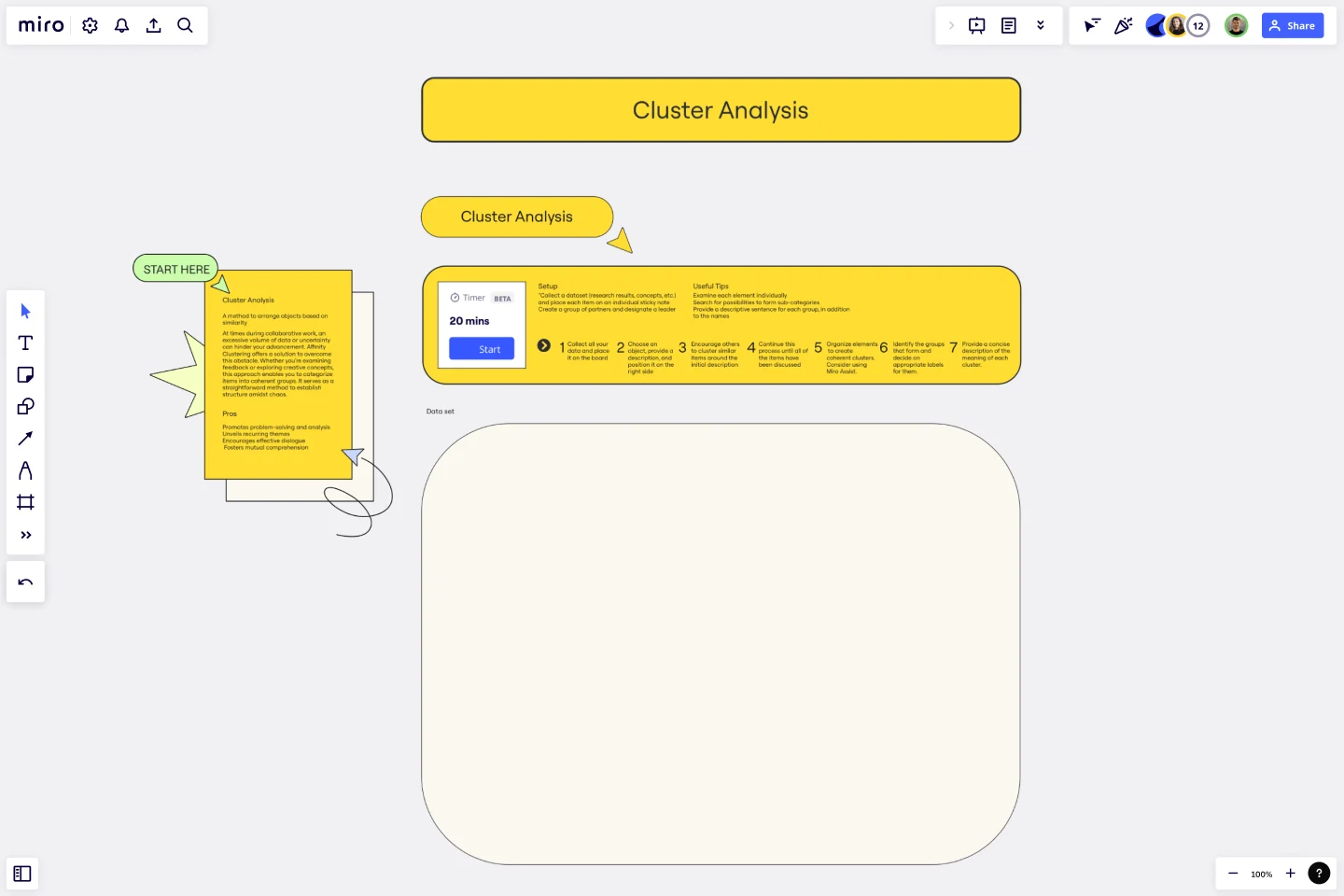Cluster Analysis Template
Arrange objects based on similarity with the Cluster Analysis Template.
About the Cluster Analysis Template
Collaborative work can be challenging, especially when dealing with a large volume of data or uncertainty. In such situations, affinity clustering can be a valuable tool to help you overcome these obstacles. This approach involves grouping items into coherent categories based on their similarities, which can help you make sense of complex information and establish structure amidst chaos.
Whether you're analyzing customer feedback or brainstorming creative concepts, affinity clustering can help you identify patterns and relationships that might not be immediately apparent. By grouping related items together, you can better understand the data and make more informed decisions.
Benefits of using the Cluster Analysis Template
Promote problem-solving and analysis.
Unveil recurring themes.
Encourage effective dialogue.
Foster mutual comprehension.
How to use the template
Collect all your data and place it on the board.
Choose an object, provide a description, and position it on the right side.
Encourage others to cluster similar items around the initial description.
Continue this process until all of the items have been discussed.
Organize elements to create coherent clusters. Consider using Miro AI.
Identify the groups that form and decide on appropriate labels for them.
Provide a concise description of the meaning of each cluster.
Setup
Collect a dataset (research results, concepts, etc.) and place each item on an individual sticky note.
Create a group of partners and designate a leader.
Useful tips
Examine each element individually.
Search for possibilities to form sub-categories.
Provide a descriptive sentence for each group, in addition to the names.
Get started with this template right now.
Analytics Storyboard
Works best for:
Planning, Storyboard, Design
Visualize your data insights with the Analytics Storyboard template. This tool is perfect for data analysts and business intelligence teams, helping you present complex data in a clear and engaging narrative format. It includes sections for data sources, key findings, and visualizations, ensuring your audience can easily understand and act on your insights. Use this template to create compelling data stories that drive informed decision-making and strategic planning.
Zoom Levels Template
The Zoom Level Template is a tool to examine a problem from various perspectives. For more innovative solutions, consider the issue broadly. Ascending the ladder enables you to broaden your perspective (ask, 'How might we?'). When confronted with an overly broad scope that hinders progress, descending the ladder helps narrow your focus (ask 'What if we narrowed?').
Storyboards by maad labs
Works best for:
Storyboard, Planning, Design
Simplify your story creation process with Storyboards by maad labs. This template offers a user-friendly interface for mapping out your narrative projects, making it ideal for both beginners and seasoned professionals. It includes sections for scene descriptions, character notes, and dialogue, helping you to organize your ideas and present them clearly. Use this template to enhance your storytelling workflow and bring your creative visions to life with ease
Idea Drafting Template
The Idea Drafting Template encourages you to tap into your innate creativity by drawing pictures to quickly generate ideas. The sketching process stimulates a cycle of creativity that supports the development of concepts. By externalizing your thoughts through sketches and seeing them visualized, you can generate variations and continue the creative process.
Mobile App Wireframe Template
Works best for:
UX, Wireframes, Mobile App Wireframe
The Mobile App Wireframe template helps you take your ideation game to the next level. Built to support UX teams, it enables you to craft impactful low-fidelity wireframes that serve as the foundation for your mobile app designs. Once you’ve completed the basic framework, you can seamlessly transform your wireframes into mockups, applying your selected theme with just one click.
Service Blueprinting Workshop
Works best for:
Agile
The Service Blueprinting Workshop template helps teams visualize and improve service processes. It includes ice breakers, context canvas, empathy maps, and action plans for service transitions. Use it to align teams, identify opportunities, and prototype service delivery from a macro to microscopic level, ensuring a comprehensive understanding of service orchestration and seamless collaboration. Ideal for remote and dispersed teams.
